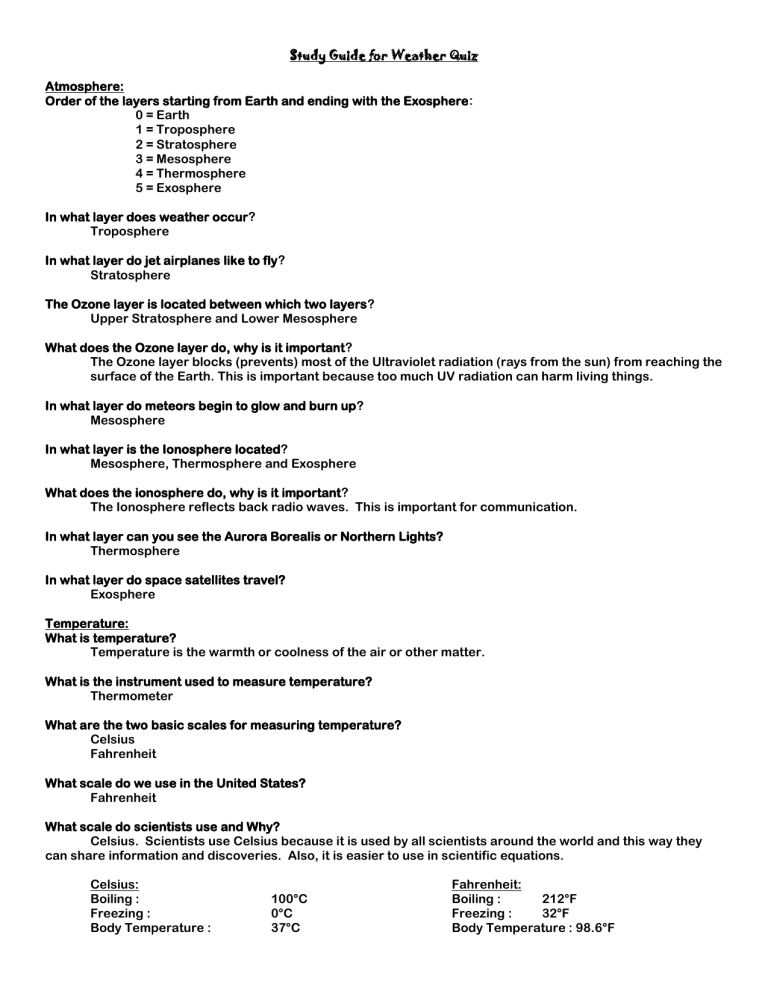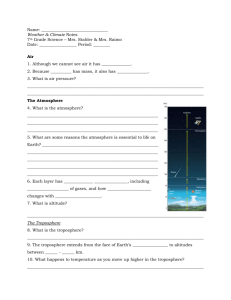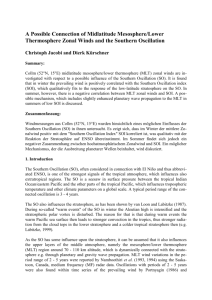Study Guide for Wind and Seasons Quiz

Study Guide for Weather Quiz
Atmosphere:
Order of the layers starting from Earth and ending with the Exosphere:
0 = Earth
1 = Troposphere
2 = Stratosphere
3 = Mesosphere
4 = Thermosphere
5 = Exosphere
In what layer does weather occur?
Troposphere
In what layer do jet airplanes like to fly?
Stratosphere
The Ozone layer is located between which two layers?
Upper Stratosphere and Lower Mesosphere
What does the Ozone layer do, why is it important?
The Ozone layer blocks (prevents) most of the Ultraviolet radiation (rays from the sun) from reaching the surface of the Earth. This is important because too much UV radiation can harm living things.
In what layer do meteors begin to glow and burn up?
Mesosphere
In what layer is the Ionosphere located?
Mesosphere, Thermosphere and Exosphere
What does the ionosphere do, why is it important?
The Ionosphere reflects back radio waves. This is important for communication.
In what layer can you see the Aurora Borealis or Northern Lights?
Thermosphere
In what layer do space satellites travel?
Exosphere
Temperature:
What is temperature?
Temperature is the warmth or coolness of the air or other matter.
What is the instrument used to measure temperature?
Thermometer
What are the two basic scales for measuring temperature?
Celsius
Fahrenheit
What scale do we use in the United States?
Fahrenheit
What scale do scientists use and Why?
Celsius. Scientists use Celsius because it is used by all scientists around the world and this way they can share information and discoveries. Also, it is easier to use in scientific equations.
Celsius:
Boiling :
Freezing :
Body Temperature :
100°C
0°C
37°C
Fahrenheit:
Boiling :
Freezing :
212°F
32°F
Body Temperature : 98.6°F
Heating the Earth’s Surface:
What shape is the Earth?
Sphere
Does the sun heat the Earth evenly? Why?
No, for the following reasons: The Earth is tilted, it rotates around the sun, it is a sphere and land and water heat differently
Why do inland and coastal areas have temperature differences?
Land and water heat differently. Water takes longer to heat up and cool down and therefore moderates the temperature.
What is the difference between weather and climate?
Weather is the state of the atmosphere in an area for a short period of time. Climate is the measure of atmospheric patterns in an area over long periods of time.
Air pressure:
What is air pressure?
Air pressure is the weight of a column of air pushing down on an area or surface of the Earth.
What two things affect air pressure?
Air pressure is affected by the amount of air above the area (altitude or elevation)
Temperature of the air
Moisture in the air
What type of weather does a high-pressure area typically indicate?
Cooler drier air and good weather, clear skies
High Pressure indicates nice weather: o Light winds o Steady temperatures o Little change in weather
What type of weather does a low-pressure area typically indicate?
Warmer moister air and wet weather, cloudy with precipitation
Low Pressure indicates a storm: o Strong winds o Dropping temperatures o Cloudy skies o Precipitation
What is the instrument used to measure air pressure?
Barometer
What unit is barometric pressure typically recorded in?
Millibars, mm Hg , or inHg
Wind:
Warm air has low pressure and rises and cold air has high pressure and sinks. When warm air rises, cold air rushes in to replace it. What is the cycle of warm air rising, while being replaced by cold air an example of?
The type of heat transfer is convection.
Why do air masses move, what are they trying to do?
Air masses move in an effort to even out. They want to be equal.
Wind is created because …..?
All winds are caused by differences in air pressure.
Most differences in air pressure are caused by unequal heating of the atmosphere (Earth).
What is the definition of wind?
Wind is the movement of air from an area of high pressure to an area of lower pressure. Wind is moving air.
What instrument measures wind speed?
The instrument which measures wind speed is the anemometer.
What are local winds?
Local winds are winds that blow over short distances in a certain area.
Examples: sea breezes and land breezes.
What are global winds?
Global winds are winds that blow steadily from specific directions over long distances.
Examples: trade winds, prevailing Westerlies, and polar easterlies.
Draw a Land and Sea Breeze Diagram. Explain why this occurs.
In a sea breeze, the air molecules over the land are heating and rising faster than the air molecules over water so the cooler air molecules over water have more pressure and rush toward land as a sea breeze.
In a land breeze the air molecules over the sea are heating from the heat stored in the water and they rise faster than the air molecules over the land so the cooler air molecules have more pressure and rush to the sea as a land breeze
Draw what the molecules look like in a solid, liquid, and gas
Label the changes that occur when energy is released or absorbed.
MELTING VAPORIZING, EVAPORATING
FREEZING CONDENSING
Know the four factors that interact to create weather:
Air Pressure
Wind
Moisture
Heat Energy/The Sun
Explain what is happening in this diagram using the 4 factors and water cycle words. Be complete.
List and describe different cloud formations.
Cirrus
Stratus
Cumlus
List and describe different forms of precipitation and what conditions exist for them to occur.
List and describe severe weather situations that may occur around the world.
What can you do to be safe in a storm? Explain.








